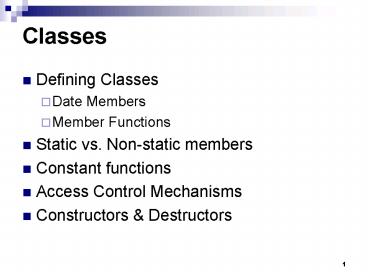Classes - PowerPoint PPT Presentation
1 / 16
Title:
Classes
Description:
Class. Consists of both data and ... Global to class all objects share the same copy ... Acts as public for objects of its own class and derived classes ... – PowerPoint PPT presentation
Number of Views:87
Avg rating:3.0/5.0
Title: Classes
1
Classes
- Defining Classes
- Date Members
- Member Functions
- Static vs. Non-static members
- Constant functions
- Access Control Mechanisms
- Constructors Destructors
2
Classes Objects
- Four pillars of OOP are achieved from classes
- Encapsulation
- Data hiding
- Inheritance
- Polymorphism
- Class
- Consists of both data and functions/methods
- Defines properties and behavior of set of
entities - Defines a new type (like int, float etc.)
- Object
- An instance of class
- Has identity, state, and behavior
3
Classes Objects
class Rectangle private int width
int length public void set(int w, int
l) int compute_area()
Rectangle r1 Rectangle r2 Rectangle r3
int a
4
Defining a class
class Rectangle private int width
int length public void set(int w, int
l) int compute_area()
- class class_name
- Access_Control_label
- members
- (data code)
- Access_Control_label
- members
- (data code)
5
Class Definition Data Members
- Abstracts the general attributes of the entity
defined by class - Type can be anything built-in or user-defined
6
Static Data Member
Rectangle r1 Rectangle r2 Rectangle r3
class Rectangle private int width
int length static int count public
void set(int w, int l) int compute_area()
count
r1
r2
width length
width length
width length
r3
7
Class Definition Member Functions
- Non-static Member Function
- Invoked from objects object.function()
- Can access both static and non-static data
members - Static Member Function
- Invoked using class classnamefunction()
- Can only access static data members (but not
non-static) - Constant Member Function
- Does not modify the state of the object !
- Const function can be invoked from both const
non-const objects - Non-const function can be invoked only from
non-const object
8
Define a Member Function
class Rectangle private int width,
length public void set (int w, int l)
int compute_area() return widthlength
void Rectangle set (int w, int l) width
w length l
r1.set(5,8) rp-gtset(8,10)
9
Constant Member Functions
- const member function
- declaration
- return_type func_name (para_list) const
- definition
- return_type func_name (para_list) const
- return_type class_name func_name (para_list)
const - Makes no modification about the data members
(safe function) - It is illegal for a const member function to
modify a class data member
10
Example of Const Member Function
class Time private int hrs,
mins, secs public void Write ( )
const
function declaration
function definition
void Time Write( ) const cout ltlthrs ltlt
ltlt mins ltlt ltlt secs ltlt endl
11
Access Control Specifiers
- Mechanism to achieve Information Hiding
- To prevent the internal representation from
direct access from outside the class - Public
- Can be accessible from anywhere in the program
- Private (default)
- Can be accessible only from member functions and
friends - Protected
- Acts as public for objects of its own class and
derived classes - Acts as private to rest of the program
- Public functions Class Interface
- Private functions helper functions (can be
accessed by class objects and friends)
12
class Time Specification
class Time public void Set
( int hours , int minutes , int seconds )
void Increment ( ) void Write ( )
const Time ( int initHrs, int initMins,
int initSecs ) // constructor Time ( )
// default
constructor private int hrs
int mins
int secs
12
13
Class Interface Diagram
Time class
Set
Private data hrs mins secs
Increment
Write
Time
Time
14
What is an object?
OBJECT
set of methods (public member functions) interna
l state (values of private data members)
Operations Data
15
Declaration of an Object
class Rectangle private int width
int length public void set(int w, int
l) int compute_area()
main() Rectangle r1 Rectangle
r2 r1.set(5, 8) coutltltr1.compute_area()ltlten
dl r2.set(8,10) coutltltr2.compute_area()ltltendl
16
Take Home Message
- Class can be considered as a user-defined data
type, while an object is just a variable of
certain class. - There are three parts in the definition of a
class data members, member functions, and access
control.































